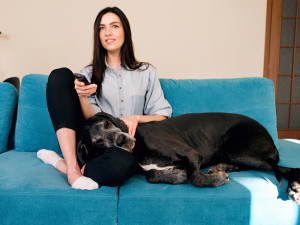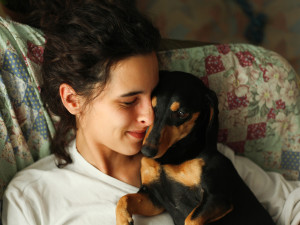
Share Article
I’ve had a summer of delicious travel — my first international trip in three years, two gorgeous weddings in beautiful locations. After that, I will be with all my friends in one place for one glorious weekend, and thankfully, I think that’s it. The minute I feel an anticipatory thrill about my upcoming adventures, there’s a twinned heartbreak because leaving home means I have to leave the dog.
The dog, a 75-five pound brindle boy who doesn’t really like the car, is not coming along for any of this. We have wonderful friends who can watch him, and I feel lucky I know he’s in great hands. I will, however, miss that handsome, dopey face with the funny white snout, the yellow-brown eyes, and the irregular, tiny little teeth.
To see this beautiful face, I always try to FaceTime him. I never FaceTime, I don’t even like to FaceTime with my partner, Megan, really, unless it’s been several days. If I know Finn is in the room with them while I’m traveling, I’m immediately pressing the video button. This is an entirely one-sided endeavor. The dog does not care. Never have I ever tried something, so repeatedly, so unrequited. My partner will be assiduously holding up the FaceTime to him, and he’ll turn away. I speak in the highest voice possible. Sometimes, Megan assures me that the dog wagged his tail when he heard my voice. But his attention is not sustained, and the screen does nothing for him. And then, in turn, I break my own heart. When I learned about a new DogPhone in development, which would allow dogs to call their parents, I just felt certain Finn would never use it!
How’s the Connection?
What was the problem here? To put it simply: “Dogs definitely do not understand FaceTime or phone calls,” says Dr. Nathan Lents, a biology professor at John Jay Collegeopens in new tab. “The issue here is that dogs, like most snouted mammals, navigate their world with their incredible noses. Their sense of smell is millions of times more sensitive and more precise than ours. We can’t even really comprehend what that is like.”

Conversely, dogs cannot comprehend what the phone is like at all. “Dogs identify things and people by their unique scent, much more than visual and audio cues, so while they may hear a familiar voice on a phone call or video, without the scent to accompany it, it just kind of confuses them and they quickly lose interest.” Even though Finn has the best ears in the house — he can hear the UPS truck’s brakes from down the block, and he will tell you every time — confused and uninterested is pretty much the territory where this dog lives.
In terms of their understanding, the visual part of the audio-visual endeavor is even more difficult. Their visual perception isn’t as precise as ours; at the same time, they can process movement more quickly, reports Dr. Lents. All in all, the experience is probably not so fun to them. “Televisions and phones in particular operate with a flicker rate of about 60 flashes per second (although we are now trending toward 120 flashes per second). This is faster than our visual centers can process, so it looks like a smoothly moving video image, but dogs have a faster flicker fusion rate and, particularly with a 60Hz display, it will appear as flashes to them, rather than a smooth video, and this is probably not pleasant to look at.”
Keep Calling — If It Makes You Happy
In summary, we’ve confirmed what I should have known: Finn doesn’t understand FaceTime, this interaction is only to soothe my heart, and it won’t work. “It’s really hard to know just what they’re picking up on,” I learn from biologist Dr. Marc Bekoffopens in new tab, the author of Canine Confidential: Why Dogs Do What They Doopens in new tab, “and often these sorts of interactions are more ‘feel good’ encounters for the human.”
My personal theories:
1. Finn’s pissed at me because I’m traveling (he usually cold-shoulders me for a day or two after I get home) so he’s refusing to greet me.
2. He’s jealous about the phone because he’d rather we pay attention to him.
These theories have all be debunked by the experts, kindly, as projection. Dr. Bekoff confirms Finn really doesn’t think much about the little rectangle in his face: “I don’t know dogs like or dislike phones, but I do think they don’t satisfy what many dogs really want and need from their and other humans: personal contact.”
In other words, what he wants, is for me to just come home already.

Maggie Lange
Maggie Lange is a writer, editor, and columnist. Her work has been featured in New York Magazine, Vice, Guernica, GQ, Rolling Stone, Pitchfork, Elle, and Bon Appetit. She lives in Philadelphia with her favorite brindle boy, Finn.
Related articles
![Muscular white pit bull stands on couch, looking out window to sunny fall day.]()
Separation Anxiety in Dogs
Does your dog freak out when you head for the door? Here’s some advice.
![]()
How I Got Through My Puppy’s Separation Anxiety Days
And survived the yowling, chewing, scratching, etc.
![Young woman hugging her small black dog on the couch]()
Who Has More Separation Anxiety — You or Your Dog?
It was a trick question. A study shows that the pandemic has made us all codependent.




